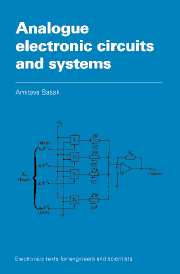7 - Data acquisition and distribution
Published online by Cambridge University Press: 05 June 2012
Summary
Objectives
At the end of the study of this chapter a student should:
be able to design different types of digital-to-analogue (D-to-A) converters
be familiar with various kinds of analogue-to-digital (A-to-D) converters; their advantages and disadvantages and be able to construct them
be familiar with the errors in the converters
be conversant with the design of discrete multiplexers and demultiplexers and be familiar with their limitations and errors
be familiar with the principles of sample-and-hold circuit and be able to design them
be able to develop a suitable data acquisition or distribution system for a particular need and find the accuracy of such a system.
In order to process analogue signals which are continuous and of varying magnitude over a period of time, with the aid of computers, conversion of analogue currents or voltages into digital codes is essential. Again, conversely, in order to control machines with the help of computers, digital signals have to be converted into analogue currents and voltages. A typical system is shown in Fig. 7.1. Here the analogue sensors measure physical quantities such as temperatures, pressures, etc., and the analogue controls switch on (or off) heaters, pumps and so on.
Sometimes it is necessary to acquire or distribute more than one signal simultaneously. This can be achieved by using the time-sharing techniques. The time required for acquiring data from many sources, or distributing data to many controls can be reduced dramatically if a single channel is time-shared for transferring data.
- Type
- Chapter
- Information
- Analogue Electronic Circuits and Systems , pp. 210 - 265Publisher: Cambridge University PressPrint publication year: 1991

